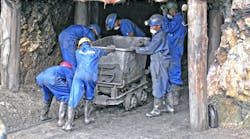Download this article in PDF format.
As the focus on environmental, social and governance (ESG) continues to increase, electronics manufacturers and distributors should be taking a closer look at their sourcing strategies and the possibility of conflict minerals infiltrating their supply chains. The metals tantalum, tin, tungsten and gold—all of which are the extracts of the minerals cassiterite, columbite-tantalite and wolframite, respectively—all fall into the conflict minerals category.
Conflict minerals can be extracted at different locations around the world, including the Democratic Republic of Congo (DRC). These minerals are mined and sold by regions experiencing some type of conflict (i.e., military, economic, etc.), and the fact that human rights violations may occur in the pursuit of these products.
According to Bloomberg, the mineral-rich region of the eastern Congo has suffered from conflict since the 1990s, when a civil war and genocide in neighboring Rwanda spread across the border, igniting a series of wars that eventually enveloped more than a half-dozen African nations. “Despite a peace agreement in 2003, more than 100 armed groups are still active in the region,” the publication adds, “which has a population of about 20 million people.”
Weak Governance and Corruption Reign
President Obama signed the Dodd-Frank Consumer Protection Act into law in 2010. Section 1502 of the act addresses the international trade and use of conflict minerals. It requires all companies that report to the Securities and Exchange Commission (SEC) to disclose whether the products they procure contain minerals that are mined in the DRC or in one of its neighboring countries.
According to a new US Government Accountability Office (GAO) report, the business world still has a long way to go in reducing and/or eliminating the presence of conflict minerals in global supply chains. In Conflict Minerals: Overall Peace and Security in Eastern Democratic Republic of the Congo Has Not Improved Since 2014, the GAO says armed groups in DRC continue to commit “severe human rights abuses, including sexual violence, and profit from the exploitation of conflict minerals.”
Battles, fatalities and attacks on civilians were relatively constant from 2014 through 2016, the GAO adds, but then steadily increased from 2017 through 2021. Citing various sources, it says that the main factors that contribute to the conflict include:
- Weak governance
- Corruption
- Natural resource exploitation
- Influence from neighboring countries (particularly Burundi, Rwanda and Uganda)
- Ethnic tensions
- Economic pressures
“Some of these factors continue to support or give rise to armed groups,” the GAO points out in the report. In 2020, for example, there were about 113 armed groups in the DRC. Those groups range from very small militias to well-organized, sophisticated groups with international recruitment, support and finance networks.
Creating and Publicizing Conflict Minerals Policies
The SEC disclosure rule broadly requires that certain companies submit a filing that describes their efforts to conduct a reasonable country-of-origin inquiry for necessary conflict minerals used in their products. In some cases, it also requires companies to perform due diligence to determine the source of their minerals.
In 2021, In total, 1,021 companies filed a conflict minerals report to the SEC. The GAO says that about 66% of companies made preliminary determinations about the origins of their conflict minerals. Of those companies that went on to perform due diligence, an estimated 47% revealed that they “couldn’t determine whether the minerals used in their products originated in covered countries,” the GAO reports.
“Companies may have hundreds of suppliers or more throughout many tiers in their supply chains,” the GAO points out. “This makes following the links all the way back to the mines a complicated endeavor.” Under the US law, there are no sanctions for a company if it discovers its minerals come from conflict zones, Bloomberg says, it’s simply required to report it.
The GAO says that over 90% of the 2021 filings that it reviewed for its report stated that companies conducted a preliminary survey of suppliers to determine whether conflict minerals may have originated in covered countries. About 43 % of companies cited lack of access to suppliers and complex supply chains as challenges to retrieving this information (i.e., 36% of companies using supplier surveys to garner the information reported a response rate of less than 100% on those surveys.
“Companies [can] mitigate these challenges by conducting outreach to suppliers to gather details not provided in survey responses,” the GAO states, “and by educating suppliers about conflict-free sourcing options, including creating and publicizing conflict minerals policies.”









